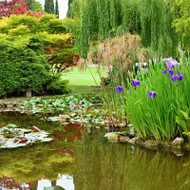
Fall Shut-Down

As the warm summer months come to an end, our most common question is, “What do I do with my pond now?”. Winterizing your pond is an important step to ensure a safe start-up next spring. Here are some easy tips to help you on your way:
- Netting
As the leaves fall it is important to make sure they don't accumulate in the bottom of your pond. You could skim them by hand every day, but to make things easier, simply place a large net over the entire pond. Clean it weekly to prevent the net from falling or from leaves slipping through and discoloring your water. - Fish Food
As the days get colder, your fish will continue to go deeper into their dormancy state. Gradually reduce the amount of food that fish receive and when the water temperature falls below 60°F, feed your WheatGerm. WheatGerm contains wheat germ which is a natural vegetable and plant-based food that is easily digested in the cold months when the fish's digestive tract is slowing. - Bacteria
Those of you who follow a routine maintenance schedule know the importance of maintaining a balanced biological population in your pond with the use of an all-natural bacteria and enzyme additive. You can continue to treat your pond in the colder months the same way you have throughout the season with our CrystalClear Spring & Fall Prep.
The cold water microbes in Spring & Fall Prep work to decompose leaves, bottom muck, and fish waste while you are tucked away inside by the fire. As Spring appears and things start to warm up the bacteria colonies help to jump-start your filter and get your pond prepped and ready for pond season. - Oxygen Exchange
As organics decompose, they produce toxic gases. Normally these gases will escape out the pond’s surface, but if your pond freezes over in the winter, they will stay in the water column and could eventually kill your fish.
It is important to keep a hole in the ice so these toxic gases may escape. You can do this by either running a pond aerator or floating a pond de-icer. In some cases, it is necessary to have both a pond aerator and a de-icer.
Note: It is much less expensive to operate a pond aerator, like the PondAir or the KoiAir, than to operate a pond de-icer. Another big advantage is that your pond aerator can be used during the warm summer months. - Equipment Maintenance
You may choose to run your system all winter, but be aware that circulating large amounts of water in the cold months can super cool the water. Water in motion can reach temperatures well below 32°F without freezing. Although colder water has more oxygen, your fish may not handle the freezing temperatures and parish.
If you choose to shut down your pump system, be sure to drain all water from your pipes, skimmers, and waterfall boxes and/or filters. Remove your pump, wash it thoroughly, place it in a five-gallon bucket of water (this keeps the seals moist), and store it in your garage or basement. - Plant Maintenance
Every type of plant needs to be taken care of in a different way. To keep it simple, trim all hardy and submerged plants to six inches above the root system and submerge at least three feet deep. Treat tropical lilies and lotuses as annuals or bring them inside to store in a heated aquarium with imitation sunlight.
Pro Tip: Use aqua gloves to keep your arms and hands completely dry and free of muck stains on your hands and nails. - Fall Cleaning
CrystalClear AlgaeOff will help remove string algae, attached debris from waterfalls, streams and rocks in seconds. AlgaeOff kills string algae, cleans debris and helps bring dead leaves to the surface for fast and easy cleanouts. AlgaeOff is a reliable and fast acting personal pond cleaner that saves you hours of time and effort and saves your fish the stress of being removed from the system while it is cleaned.
